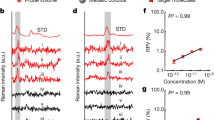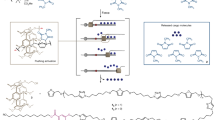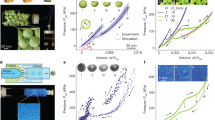Abstract
Precise understanding of biological functions requires tools comparable in size to the basic components of life1,2,3,4. Single molecule studies have revealed molecular behaviors usually hidden in the ensemble- and time-averaging of bulk experiments5,6. Although most such approaches rely on sophisticated optical strategies to limit the detection volume7,8, another attractive approach is to perform the assay inside very small containers9,10,11,12,13,14,15,16. We have developed a silicone device presenting a large array of micrometer-sized cavities. We used it to tightly enclose volumes of solution, as low as femtoliters, over long periods of time. The microchip insures that the chambers are uniform and precisely positioned. We demonstrated the feasibility of our approach by measuring the activity of single molecules of β-galactosidase and horseradish peroxidase. The approach should be of interest for many ultrasensitive bioassays at the single-molecule level.
This is a preview of subscription content, access via your institution
Access options
Subscribe to this journal
Receive 12 print issues and online access
$209.00 per year
only $17.42 per issue
Buy this article
- Purchase on Springer Link
- Instant access to full article PDF
Prices may be subject to local taxes which are calculated during checkout



Similar content being viewed by others
References
Whitesides, G.M. The “right” size in nanobiotechnology. Nat. Biotechnol. 21, 1161–1165 (2003).
Jensen, K. Smaller, faster chemistry. Nature 393, 735–736 (1998).
Wölcke, J. & Ullmann, D. Miniaturized HTS technologies – uHTS. Drug Discov. Today 6, 637–646 (2001).
Thorsen, T., Maerkl, S.J. & Quake, S.R. Microfluidic large scale interaction. Science 298, 580–584 (2002).
Lu, H.P., Xun, L. & Xie, S. Single molecule enzymatic dynamics. Science 282, 1877–1882 (1998).
Xue, Q. & Yeung, E. Differences in the chemical reactivity of individual molecules of an enzyme. Nature 373, 681–683 (1995).
Funatsu, T. et al. Imaging of single molecules and individual ATP turnovers by single myosin molecules in aqueous solution. Nature 374, 555–559 (1995).
Levene, M.J. et al. Zero-mode waveguides for single-molecule analysis at high concentrations. Science 299, 682–686 (2003).
Lipman, A.E., Shuler, B., Bakajin, O. & Eaton, W.A. Single molecule measurement of protein folding kinetics. Science 301, 1233–1235 (2003).
Foquet, M., Korlach, J., Zipfel, W.R., Webb, W.W. & Craighead, H.G. Focal volume confinement by submicrometer-sized fluidic channels. Anal. Chem. 76, 1618–1626 (2004).
Gratzl, M., Lu, H., Matsimoto, T., Yi, C. & Bright, G.R. Fine chemical manipulations of microscopic liquid samples. 1. Droplet loading with chemicals. Anal. Chem. 71, 2751–2756 (1999).
Stamou, S., Duschl, C., Delamarche, E. & Vogel, H. Self assembled microarrays of attoliter molecular vessels. Angew. Chem. Int. Ed. 42, 5580–5583 (2003).
Nagai, H., Murakami, Y., Yokoyama, K. & Tamiya, E. High-throughput PCR in silicon based microchamber array. Biosens. Bioelectron. 16, 1015–1019 (2001).
Chiu, D.T. et al. Chemical transformations in individual ultrasmall biomimetic containers. Science 283, 1892–1895 (1999).
Gosalia, D.N. & Diamond, S.L. Printing chemical library on microarrays for fluid phase nanoliter reactions. Proc. Nat. Acad. Sci. USA 100, 8721–8726 (2003).
Nakano, M. et al. Single molecule PCR using water in oil emulsion. J. Biotechnol. 102, 117–124 (2003).
Loscertales, I.G. et al. Micro/nano encapsulation via electrified coaxial liquid jets. Science 295, 1695–1698 (2002).
Renault, J.P. et al. Fabricating arrays of single protein molecules on glass using microcontact printing. J. Phys. Chem. 107, 703–711 (2003).
McDonald, J.C. & Whitesides, G.M. Poly(dimethylsiloxane) as a material for fabricating microfluidic devices. Accounts Chem. Res. 35, 491–499 (2002).
Baltussen, E., Sandra, P., David, F., Janseen, H.G. & Cramers, C. Study of the equilibrium mechanism between water and PDMS for very apolar solutes: adsorption or sorption? Anal. Chem. 71, 5213–5216 (1999).
Du Plessis, J., Pugh, J., Judefeind, A. & Hadgraft, J. The effect of the nature of H-bonding groups on diffusion through PDMS membranes saturated with octanol and toluene. Eur. J. Pharm. Sci. 15, 62–69 (2002).
Rondelez, Y. et al. Femtoliters chambers for the study of mechanically-driven ATP synthesis by F1 protein motor. in Proceedings of the 7th International Conference on Micro Total Analysis Systems, 555–558, Squaw Valley, CA, USA, October 5–9, 2003.
Horbett, T.A. & Bratsh, J.L. Proteins at interfaces. in Proteins at interfaces. Physicochemical and biochemical studies (eds. Brasch, J.L. & Horbett, T.A.) 1–33 (Amer. Chem. Soc., Washington, DC, 1987).
Wheeler, A.R. et al. Microfluidic device for single cell analysis. Anal. Chem. 75, 3581–3586 (2003).
Sapsford, K.E. & Ligler, F.S. Realtime analysis of protein adsorption to a variety of thin films. Biosensors and Bioelectronics 19, 1045–1055 (2004).
Huang, Z. Kinetic fluorescence measurement of fluorescein di-β-galactoside hydrolysis by β-Galactosidase: intermediate channelling in stepwise catalysis by a free single enzyme. Biochemistry 30, 8535–8540 (1991).
Noji, H., Yasuda, R., Yoshida, M. & Kinosita, K. Jr. Direct observation of the rotation of F1-ATPase. Nature 386, 299–302 (1997).
Ishijima, A. & Yanagida, T. Single molecule nanobioscience. Trends. Bio. Sci. 26, 438–444 (2001).
Itoh, H. et al. Mechanically driven ATP synthesis by F1-ATPase. Nature 427, 465–468 (2004).
Rondelez, Y. et al. Highly coupled ATP synthesis by F1-ATPase single molecules. Nature 433, 773–777 (2005).
Acknowledgements
This project was performed in the framework of the Laboratory for Integrated Micro Mechatronic Systems (LIMMS-CNRS/IIS), and financially supported by the Japan Society for the Promotion of Science (H.N., S.T. and H.F.), Bio-Oriented Technology Research Advancement Institution (H.N. and S.T.) and Mitsubishi Foundation (H.N. and S.T.). We thank all members of Noji, Takeuchi and Fujita laboratories for help and advice, and I. Baba and T. Kitamori for critical reading and R. Yasuda for programming of image analysis software. Y.R. and G.T. are Research Fellows of the Japan Society for the Promotion of Science.
Author information
Authors and Affiliations
Corresponding author
Ethics declarations
Competing interests
The authors declare no competing financial interests.
Supplementary information
Supplementary Fig. 1
The activity of other single enzymes can be detected inside the microchambers. (PDF 501 kb)
Supplementary Fig. 2
In the assay we used, β-Gal catalyzes the hydrolysis of nonfluorescent FDG to highly fluorescent fluorescein. (PDF 282 kb)
Rights and permissions
About this article
Cite this article
Rondelez, Y., Tresset, G., Tabata, K. et al. Microfabricated arrays of femtoliter chambers allow single molecule enzymology. Nat Biotechnol 23, 361–365 (2005). https://doi.org/10.1038/nbt1072
Received:
Accepted:
Published:
Issue Date:
DOI: https://doi.org/10.1038/nbt1072
This article is cited by
-
Functional analysis of single enzymes combining programmable molecular circuits with droplet-based microfluidics
Nature Nanotechnology (2024)
-
Micro- and nanochamber array system for single enzyme assays
Scientific Reports (2023)
-
Stability of enzyme immobilized on the nanofluidic channel surface
Analytical Sciences (2023)
-
Advances in optical counting and imaging of micro/nano single-entity reactors for biomolecular analysis
Analytical and Bioanalytical Chemistry (2023)
-
Microfluidics-based strategies for molecular diagnostics of infectious diseases
Military Medical Research (2022)



